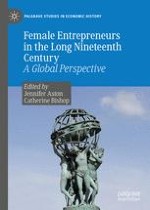2020 | OriginalPaper | Chapter
12. Female Entrepreneurship in England and Wales, 1851–1911
Authors : Carry van Lieshout, Harry Smith, Robert J. Bennett
Published in: Female Entrepreneurs in the Long Nineteenth Century
Publisher: Springer International Publishing
Activate our intelligent search to find suitable subject content or patents.
Select sections of text to find matching patents with Artificial Intelligence. powered by
Select sections of text to find additional relevant content using AI-assisted search. powered by
